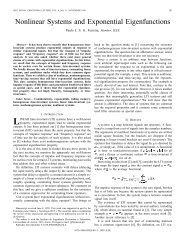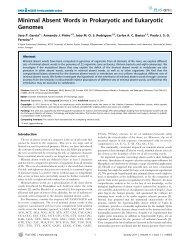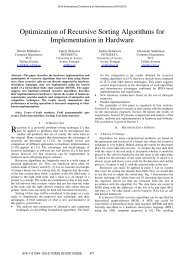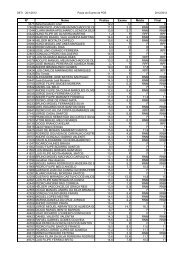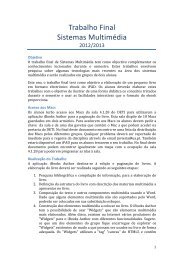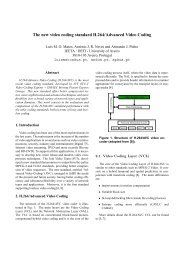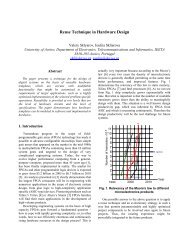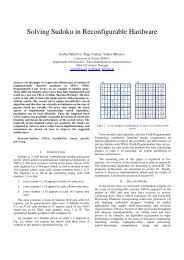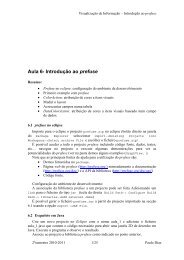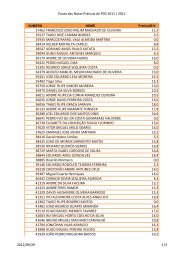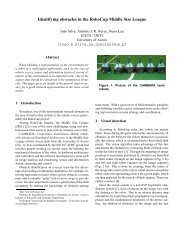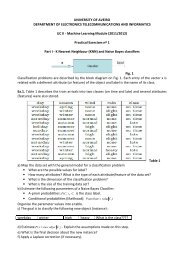Diapositivo 1 - Sweet - Universidade de Aveiro
Diapositivo 1 - Sweet - Universidade de Aveiro
Diapositivo 1 - Sweet - Universidade de Aveiro
You also want an ePaper? Increase the reach of your titles
YUMPU automatically turns print PDFs into web optimized ePapers that Google loves.
What is VTK?<br />
An Introduction to the<br />
Visualization Toolkit<br />
Information Visualization – Paulo Dias<br />
• Open Source library based in Object<br />
Oriented Programming<br />
• multi-platform (Windows/Unix/Mac)<br />
• C++ implementation with several wrappers<br />
for other languages (Tcl/Tk-Python-Java)<br />
• No User Interface but possible to integrate<br />
with several libraries: Tk, Motif, Visual<br />
Studio, Qt, …<br />
Instituto <strong>de</strong><br />
Engenharia Electrónica e<br />
Telemática<br />
<strong>de</strong> <strong>Aveiro</strong><br />
z<br />
Departamento <strong>de</strong><br />
Electrónica, Telecomunicações e Informática<br />
<strong>Universida<strong>de</strong></strong> <strong>de</strong> <strong>Aveiro</strong><br />
<strong>de</strong>ti <strong>de</strong>partamento <strong>de</strong> electrónica telecomunicações e informática<br />
universida<strong>de</strong> <strong>de</strong> aveiro<br />
2<br />
VTK Goals<br />
• Scientific Visualization<br />
• Information Visualization<br />
• Large Data Visualization<br />
• Volume ren<strong>de</strong>ring<br />
• 3D Interaction<br />
What we get<br />
• Several data representation: points,<br />
polygonal meshes, images, volumes,<br />
structured and unstructured grids.<br />
• Importers and exporters for several<br />
formats allowing data exchange between<br />
applications.<br />
• Hundreds of filters for data processing.<br />
3<br />
4<br />
The origin<br />
• VTK Started December 1993<br />
as supporting software for the<br />
book “ The visualization Toolkit:<br />
An Object Oriented Approach<br />
to 3D Graphics” by Will<br />
Schroe<strong>de</strong>r, Ken Martin and Bill<br />
Lorensen (Prentice Hall).<br />
• Supported by Kitware<br />
company:<br />
http://public.kitware.com/VTK/<br />
• Software, Books, FAQ’s,<br />
examples, forums…<br />
Main characteristics<br />
• High level of abstraction when compared<br />
with other libraries such as OpenGL.<br />
• Support all the main visualization<br />
algorithms.<br />
• Hundred of classes and functions.<br />
• Key to success:<br />
– Get used to the objects.<br />
– Use examples.<br />
5<br />
6<br />
1
Architecture<br />
• C++ core: inclu<strong>de</strong> data structures,<br />
algoritms and co<strong>de</strong>.<br />
• Interpretation layers: to allow use with<br />
several languages :<br />
– C++<br />
– Tcl<br />
– JAVA<br />
– Python<br />
VTK subsystems<br />
• Graphics<br />
• Image Processing (2D and 3D ImageData<br />
and Filter)<br />
• 3D Geometry (DataSets and Filters)<br />
• Picking, Interactions<br />
• 2D Chart API<br />
• Information Visualization<br />
7<br />
8<br />
VTK Visualization Pipeline<br />
VTK Graphic<br />
data mappers actors<br />
• Just like hollywood: Lights, Cameras,<br />
Actors, Properties. The graphics mo<strong>de</strong>l<br />
inclu<strong>de</strong>s tools for<br />
– Window managing (Creation and<br />
manipulation of ren<strong>de</strong>ring windows).<br />
– Mappers and their properties.<br />
– 2D, 3D and volume ren<strong>de</strong>ring.<br />
9<br />
10<br />
VTK Graphic<br />
Dataset<br />
A VTK scene consists of:<br />
• vtkRen<strong>de</strong>rWindow - contains the final image<br />
• vtkRen<strong>de</strong>rer - draws into the ren<strong>de</strong>r window<br />
• vtkActor - combines properties / geometry<br />
– vtkProp, vtkProp3D<br />
– vtkProperty<br />
• vtkLights - illuminates actors<br />
• vtkCamera - ren<strong>de</strong>rs the scene<br />
• vtkMapper - represents geometry<br />
– vtkPolyDataMapper, vtkDataSetMapper are subclasses<br />
• vtkTransform - positions actors<br />
• Dataset structure consists of<br />
– points (x-y-z coordinates)<br />
– cells (e.g., polygons, lines, voxels) which are<br />
<strong>de</strong>fined by connectivity list referring to points<br />
ids<br />
• Access is via integer ID<br />
Points<br />
Cell<br />
11<br />
12<br />
2
Data Representation - Cells and points<br />
Data Types<br />
• 5 different type of data:<br />
• Vertex<br />
• Polyvertex<br />
• Line<br />
• Polyline<br />
• Triangle<br />
• Triangle Strip<br />
• Quadrilateral<br />
• Polygon<br />
• Tetrahedron<br />
• Hexahedron<br />
• Voxel<br />
– vtkImageData - Structured Points<br />
– vtkRectilinear Grid - Rectilinear Grid<br />
– vtkStructuredGrid - Structured Grid<br />
– vtkUnstructuredGrid - Unstructured Grid<br />
– vtkPolyData - Polygonal Data<br />
• Format choice is important for efficiency and for use<br />
of a<strong>de</strong>quate filters<br />
13<br />
14<br />
DataSet Attributes<br />
• vtkDataSet also has point and cell<br />
attribute data:<br />
– Scalars<br />
– Vectors - 3-vector<br />
– Tensors - 3x3 symmetric matrix<br />
– Normals - unit vector<br />
– Texture Coordinates 1-3D<br />
– Array of arrays (i.e. FieldData)<br />
VTK –Example<br />
#inclu<strong>de</strong> "vtkConeSource.h"<br />
#inclu<strong>de</strong> "vtkPolyDataMapper.h"<br />
#inclu<strong>de</strong> "vtkActor.h"<br />
#inclu<strong>de</strong> "vtkRen<strong>de</strong>rWindow.h"<br />
#inclu<strong>de</strong> "vtkRen<strong>de</strong>rWindowInteractor.h"<br />
#inclu<strong>de</strong> "vtkRen<strong>de</strong>rer.h"<br />
#inclu<strong>de</strong> "vtkProperty.h"<br />
void main ()<br />
{<br />
// create cone geometry<br />
vtkConeSource *cone =<br />
vtkConeSource::New();<br />
// create cone mapper for mapping the cone<br />
to the graphics library.<br />
vtkPolyDataMapper *coneMapper =<br />
vtkPolyDataMapper::New();<br />
coneMapper ->SetInput(cone->GetOutput());<br />
// actor coordinates geometry, properties,<br />
transformation<br />
vtkActor *aCone = vtkActor::New();<br />
aCone->SetMapper(coneMapper);<br />
aCone->GetProperty()->SetColor(0,0,1); //<br />
cone color blue<br />
// an interactor<br />
vtkRen<strong>de</strong>rWindowInteractor *iren =<br />
vtkRen<strong>de</strong>rWindowInteractor::New();<br />
iren->SetRen<strong>de</strong>rWindow(renWin);<br />
// add the actor to the scene<br />
ren1->AddActor(aCone);<br />
ren1->SetBackground(1,1,1); //<br />
Background color white<br />
// ren<strong>de</strong>r an image<br />
renWin->Ren<strong>de</strong>r();<br />
// begin mouse interaction<br />
iren->Start();<br />
cone->Delete();<br />
coneMapper->Delete();<br />
aCone->Delete();<br />
ren1->Delete();<br />
renWin->Delete();<br />
iren->Delete();<br />
}<br />
15<br />
// a ren<strong>de</strong>rer and ren<strong>de</strong>r window<br />
vtkRen<strong>de</strong>rer *ren1 = vtkRen<strong>de</strong>rer::New();<br />
vtkRen<strong>de</strong>rWindow *renWin =<br />
vtkRen<strong>de</strong>rWindow::New();<br />
renWin->AddRen<strong>de</strong>rer(ren1);<br />
16<br />
vtkRen<strong>de</strong>rWindowInteractor<br />
• SetRen<strong>de</strong>rWindow – ren<strong>de</strong>r window<br />
• Key and mouse bindings (Interactor Style)<br />
• Light Follow Camera (a headlight)<br />
• Picking interaction<br />
Interactor Styles<br />
• Button 1 – rotate<br />
• Button 2 – translate ( Button 1 for 2-button<br />
• mouse)<br />
• Button 3 – zoom<br />
• Keypress e or q – exit<br />
• Keypress f – “fly-to” point un<strong>de</strong>r mouse<br />
• Keypress s/w – surface/wireframe<br />
• Keypress p – pick<br />
• Keypress r – reset camera<br />
• Keypress 3 – toggle stereo<br />
Switch styles: Keypress j – joystick; t - trackball<br />
style<br />
17<br />
18<br />
3
Picking<br />
• vtkPropPicker - hardware-assisted picking of<br />
vtkProps (returns vtkProp picked and x,y,z<br />
coordinate)<br />
• vtkWorldPointPicker - get x-y-z coordinate; does not<br />
pick prop (hardware assisted, returns x,y,z<br />
coordinate)<br />
• vtkPicker - pick based on prop3D’s bounding box<br />
(software ray cast – returns vtkProp)<br />
• vtkPointPicker - pick points (closest point to camera<br />
within tolerance - software ray cast – returns point id<br />
& x,y,z coordinate)<br />
• vtkCellPicker - pick cells (software ray cast –<br />
returns cell id & x,y,z)<br />
3D Widgets<br />
• Ad<strong>de</strong>d since VTK 4.0 release<br />
• Requires version 4.2 or later<br />
• Subclass of vtkInteractorObserver<br />
• Interactor observers watch events<br />
invoked on vtkRen<strong>de</strong>rWindowInteractor<br />
• Events are caught and acted upon<br />
• Events can be prioritized and or<strong>de</strong>red<br />
19<br />
20<br />
3D Widgets<br />
• vtkPointWidget<br />
• vtkLineWidget<br />
• vtkPlaneWidget<br />
• vtkImplicitPlaneWidget<br />
• vtkImagePlaneWidget<br />
• vtkBoxWidget<br />
• vtkSphereWidget<br />
• …..<br />
Algorithms / Filters<br />
• Algorithms operate on data objects<br />
source<br />
data<br />
filter<br />
data<br />
mapper<br />
s<br />
actors<br />
21<br />
22<br />
Algorithms / Filters<br />
• vtkAppendFilter<br />
• vtkAppendPolyData<br />
• vtkBooleanTexture<br />
• vtkBrownianPoints<br />
• vtkCastToConcrete<br />
• vtkCellCenters<br />
• vtkCellDataToPointData<br />
• vtkCullVisiblePoints<br />
• vtkCleanPolyData<br />
• vtkClipPolyData<br />
• vtkEdgePoints<br />
• vtkElevationFilter<br />
• vtkExtractEdges<br />
• vtkExtractGeometry<br />
• vtkExtractGrid<br />
• vtkExtractTensorComponent<br />
s<br />
• vtkExtractUnstructuredGrid<br />
• vtkExtractVOI<br />
• vtkExtractVectorComponents<br />
• vtkFeatureEdges…<br />
Vtk Chart API<br />
• Multiple chart types<br />
– Line plots<br />
– Bar graphs<br />
– Scatter plots<br />
– Area charts<br />
– Pie charts<br />
– Flood plots<br />
23<br />
24<br />
4
VTK chart API<br />
Information Visualization in VTK<br />
• Titan project 2008 - collaborative effort<br />
between Sandia National Laboratories and<br />
Kitware Inc.<br />
• One of the first software <strong>de</strong>velopment<br />
efforts to address the merging of scientific<br />
visualization and information visualization<br />
25<br />
26<br />
VTK infoVis<br />
VTK infoVis<br />
vtkTable<br />
vtkDataObject<br />
vtkArray<br />
vtkGraph<br />
vtkTable<br />
vtkGraph (network)<br />
vtkDirectedGraph<br />
vtkTree (hierarchy)<br />
vtkDirectedAcyclicGraph<br />
vtkUndirectedGraph<br />
vtkArray<br />
vtkTree<br />
From:<br />
http://titan.sandia.gov/media/Information_Visualization_in_VTK.pdf<br />
27<br />
vtkMutableDirectedGraph<br />
vtkMutableUndirectedGraph<br />
28<br />
From: http://titan.sandia.gov/media/Information_Visualization_in_VTK.pdf<br />
VTK infoVis<br />
VTK infoVis<br />
AND MORE:<br />
– Data conversion<br />
– Database access<br />
– Graph algorithms<br />
– Statistics<br />
vtkGraphLayout<br />
vtkTreeMapView<br />
From: http://titan.sandia.gov/media/Information_Visualization_in_VTK.pdf<br />
29<br />
From: http://titan.sandia.gov/media/Information_Visualization_in_VTK.pdf<br />
30<br />
5
Main advantages<br />
Main problems<br />
– Free<br />
– Easy creation of graphical applications<br />
– C++ source co<strong>de</strong> available<br />
– Make learning of computer Graphics,<br />
Visualization and Image Processing easier.<br />
– Platform in<strong>de</strong>pen<strong>de</strong>nt.<br />
– Large quantity of widgets for object<br />
manipulation<br />
– Integrate software (not a series of pieces of<br />
co<strong>de</strong>).<br />
– Easy visualization of data<br />
– Object Oriented<br />
– Largely used in many commercial<br />
applications, almost standard<br />
31<br />
– Not very fast<br />
– Relatively heavy, need a reasonable machine<br />
– Documentation<br />
32<br />
Help<br />
3D Mo<strong>de</strong>lling and Visualization Course<br />
• VTK User’s Gui<strong>de</strong><br />
• The Visualization Toolkit TextBook<br />
• Doxygen Documentation<br />
• Kitware pages on VTK (examples, testing,<br />
etc…)<br />
FootVR<br />
3D Audio<br />
Brain Imaging<br />
Vectorial Data<br />
2D Audio<br />
Polygonal Meshes<br />
Cutting<br />
33<br />
34<br />
3D Mo<strong>de</strong>lling and Visualization Course<br />
3D Mo<strong>de</strong>lling and Visualization Course<br />
Geoscience data<br />
RIR Acquisition<br />
Medical data<br />
Robotic simulators<br />
35<br />
36<br />
6
VTK Installation<br />
• Download Cmake<br />
http://www.cmake.org/cmake/resources/softwar<br />
e.html<br />
• Download VTK<br />
http://www.vtk.org/VTK/resources/software.html<br />
VTK Installation - Cmake<br />
• Run Cmake -indicate source directory (VTK files)<br />
and where to build binaries.<br />
• Choose compiler (for example Visual Studio 9 –<br />
VS2008)<br />
37<br />
38<br />
VTK Installation - Cmake<br />
• Configure compilation options, namely:<br />
– BUILS_SHARED_LIBS<br />
– VTK_WRAP_JAVA<br />
– CMAKE_INSTALL_PREFIX (directory for<br />
installation)<br />
– VTK_USE_CHARTS<br />
– VTK_USE_INFOVIS<br />
• Click on configure<br />
VTK Installation - Compilation<br />
• Open Project in Visual Studio (solution is in<br />
binary directory with name: vtk.sln)<br />
• Build all (take some time)<br />
• run install project to copy files to install directory<br />
• Add Install directory in path<br />
39<br />
40<br />
VTK Installation – Visual Studio<br />
1. Indicate location of hea<strong>de</strong>r files [configuration properties-<br />
>C/C++->General]. In [Additional Inclu<strong>de</strong> Directories] inclu<strong>de</strong><br />
hea<strong>de</strong>r file directory: [ex:”C:\Program Files\VTK\inclu<strong>de</strong>\vtk“]<br />
VTK Installation – Visual Studio<br />
2. Indicate location of library files [configuration properties->Linker-<br />
>Genera]. In [Additional Library Directories] inclu<strong>de</strong> lib file<br />
directory: [ex:” C:\Program Files\VTK\lib“]<br />
41 42<br />
7
VTK Installation – Visual Studio<br />
3. In Linker->Input->Additional Depen<strong>de</strong>ncies, inclu<strong>de</strong> lib files:<br />
vtkCommon.lib vtkFiltering.lib vtkGraphics.lib vtkHybrid.lib<br />
vtkImaging.lib vtkIO.lib vtkjpeg.lib vtkpng.lib vtkRen<strong>de</strong>ring.lib vtkzlib.lib<br />
vtkWidgets.lib<br />
4. Add vtk DLL directory to the path. In windows can be done thorugh<br />
Control Panel->System->Advanced->Environment variables<br />
and rebooting computer<br />
VTK Installation - netbeans<br />
• Add vtk.jar to the project (right click, libraries).<br />
• Ensure that vtk DLL files are in the path.<br />
• Add the import to the JAVA file:<br />
System.loadLibrary("vtkCommonJava");<br />
System.loadLibrary("vtkFilteringJava");<br />
System.loadLibrary("vtkViewsJava");<br />
System.loadLibrary("vtkImagingJava");<br />
System.loadLibrary("vtkInfovisJava");<br />
System.loadLibrary("vtkGraphicsJava");<br />
System.loadLibrary("vtkRen<strong>de</strong>ringJava");<br />
In VTK (5.8.1), Java wrapping is missing for<br />
vtkChart API. To create the wrapper, copy vtk.jar<br />
to vtk.zip, unzip the file, and run javac *.java insi<strong>de</strong><br />
the unzipped file to wrap all the classes for JAVA,<br />
the zip the files into vtk.jar again.<br />
43<br />
44<br />
8



